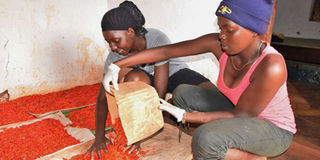Chilies stave off hunger in Ganze

Beatrice Vidzo Gona and her sister Loice Furaha spread their Thai chilies harvest to dry at their mother's farm in Dzikunze Village in Ganze Sub-county, Kilifi. A kilogramme of the chilli goes for Sh100 in Mombasa. PHOTO | WACHIRA MWANGI | NMG
What you need to know:
- The women say despite the harsh weather conditions and lack of water for irrigation farming can thrive.
- The mother of four sells most her harvest to a company in Malindi and a little in markets in Kilifi and Mombasa counties where most of her customers are Kenyans of Asian origin.
- A kilogramme of bird’s eye chilli goes for Sh100 in Mombasa.
- Three months after planting, Ms Kadenge says a farmer can harvest the crop.
For ages, residents of Ganze in Kilifi County have been depending on relief food since the region is notorious for persistent rain shortage.
The sub-county is one of the least resource-endowed constituencies not only at the Coast but in Kenya as a whole. Not even devolution has brought about meaningful change to the region. So bad is the situation that residents still depend on relief food.
But a section of women in Dzikunze village want to change the situation by engaging in agricultural activities.
The women say despite the harsh weather conditions and lack of water for irrigation farming can thrive.
Mariamu Kadenge, 45, started cultivating bird’s eye chilli or Thai chilli, as it is commonly known, five years ago to help her raise fees for her children’s education.
Today, her success is inspiring other women to cultivate the pepper that is flourishing in the area.
“Although Ganze has for years been visited by ravaging famine we are here to show the world that with resources we can do it. We just urge the government to dig boreholes that we can use to water our plants,” said Ms Kadenge.
Seeds of Gold met her teaching other women how to farm the chillies at her farm.
The mother of four sells most her harvest to a company in Malindi and a little in markets in Kilifi and Mombasa counties where most of her customers are Kenyans of Asian origin.
“They love the chillies which they use in their cooking. I started cultivating this type of crop due to lack of employment and because other plants performed poorly due to the harsh weather conditions. I plant, harvest and take the produce to a company in Malindi. We are paid. In a good month I get Sh10,000,” said Ms Kadenge.
A kilogramme of bird’s eye chilli goes for Sh100 in Mombasa.
“But the company that buys the chilli at our farms buys at Sh60 then sells at Sh100 making more profits. The biggest challenge is the middleman. If we take our plants to Mombasa we get more cash unlike when we take them to the middlemen who comes to collect it from our farms,” she added.
Three months after planting, Ms Kadenge says a farmer can harvest the crop.





